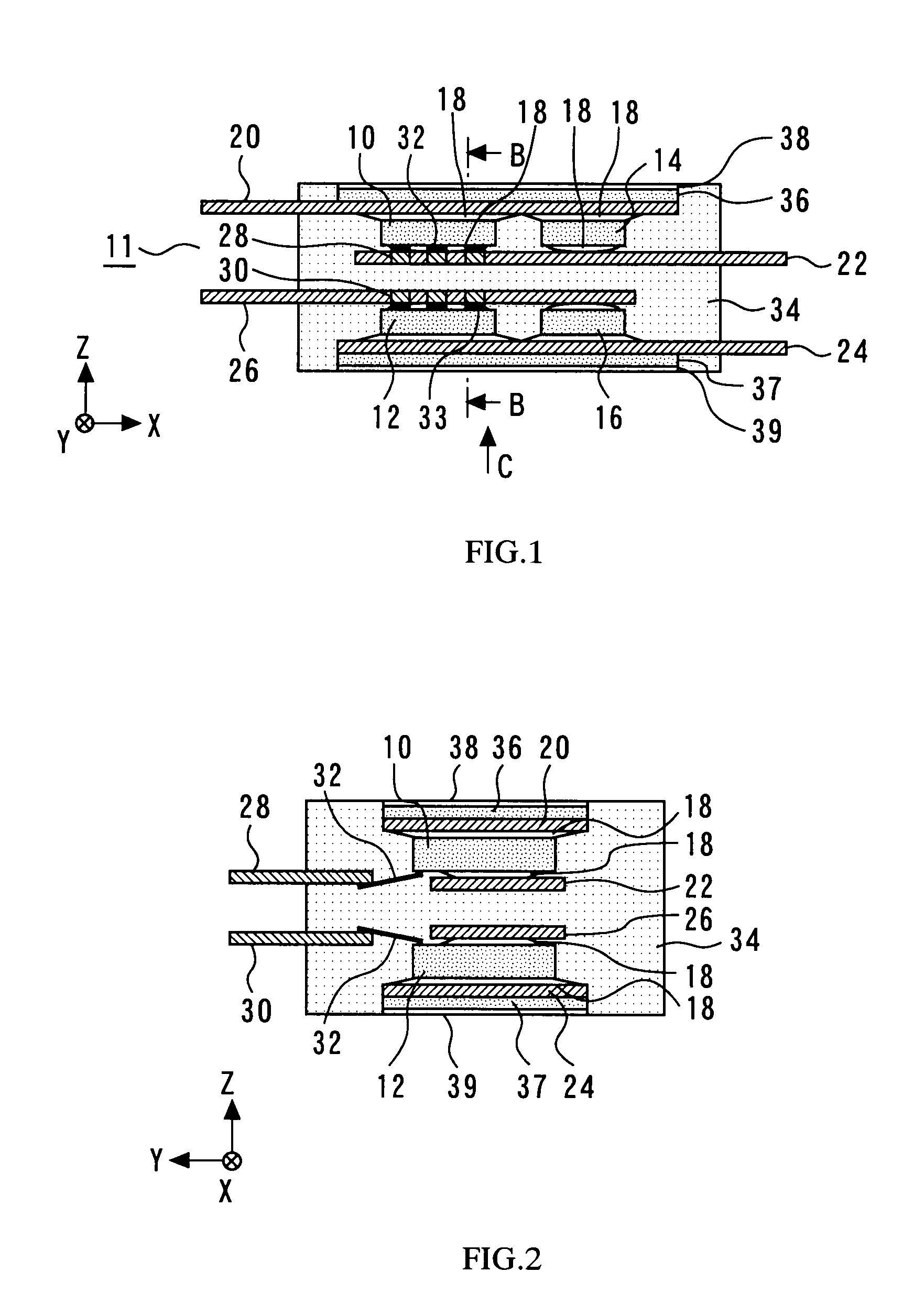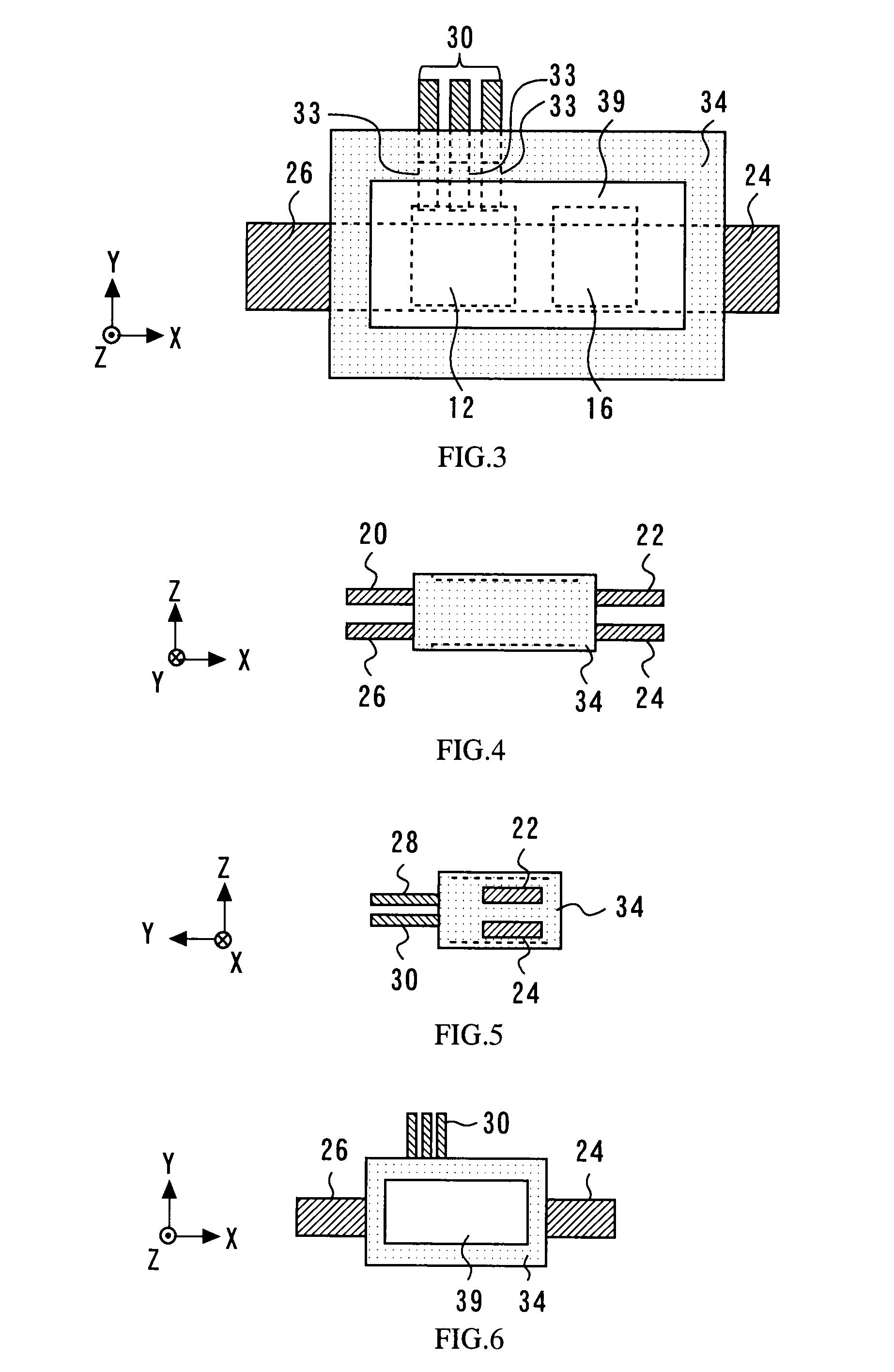Resin sealed semiconductor device and manufacturing method therefor
a technology of sealing and semiconductors, applied in semiconductor devices, semiconductor/solid-state device details, electrical devices, etc., can solve the problems of not allowing excessive force to be applied, unable to sufficiently improve the heat dissipation characteristics of the device, and unable to reduce the footprint of the device, so as to achieve the effect of reducing the footprint and improving the heat dissipation characteristics
- Summary
- Abstract
- Description
- Claims
- Application Information
AI Technical Summary
Benefits of technology
Problems solved by technology
Method used
Image
Examples
first embodiment
[0067]A first embodiment of the present invention relates to a resin sealed semiconductor device having a reduced size and improved heat dissipation characteristics, and also relates to a method for manufacturing such a resin sealed semiconductor device. FIG. 1 is a cross-sectional view of the resin sealed semiconductor device, 11, of the present embodiment. The resin sealed semiconductor device 11 includes a first IGBT 10 having a gate and an emitter formed in its top surface (the lower surface as viewed in FIG. 1) and a collector formed in its bottom surface (the upper surface as viewed in FIG. 1). A first control terminal 28 is connected to the gate of the first IGBT 10 through a first internal wire 32, and a first emitter terminal 22 is connected to the emitter of the first IGBT 10 by solder 18. Further, a first collector terminal 20 is connected to the collector of the first IGBT 10 by solder 18.
[0068]The resin sealed semiconductor device 11 further includes a first diode 14 ha...
second embodiment
[0101]A second embodiment of the present invention relates to a resin sealed semiconductor device having a simplified configuration and yet having improved heat dissipation characteristics and electrical characteristics. FIG. 10 is a cross-sectional view of this resin sealed semiconductor device. In FIG. 10 those components common to FIG. 1 retain the same reference numerals and will not be further described. It should be noted that only so much of this embodiment will be described as necessary for an understanding of its features as compared to those of the first embodiment.
[0102]According to the present embodiment, a first heat spreader 72 is bonded, by solder 18, to the bottom surface (the upper surface as viewed in FIG. 10) of the first IGBT 10 and to the surface of the first diode 14 having a cathode formed therein. Further, a second heat spreader 76 is bonded, by solder 18, to the bottom surface (the lower surface as viewed in FIG. 10) of the second IGBT 12 and to the surface ...
third embodiment
[0118]A third embodiment of the present invention relates to a resin sealed semiconductor device in which the upper and lower structures are stacked one on the other without any gap and integrally sealed using a resin, and also relates to a method for manufacturing such a resin sealed semiconductor device. The present embodiment will be described with reference to FIGS. 20, 21, 22, and 23. The resin sealed semiconductor device of the present embodiment includes a first IGBT 200 and a second IGBT 202 each having a gate and an emitter formed in its top surface and a collector formed in its bottom surface. The resin sealed semiconductor device also includes a first diode 212 and a second diode 214 each having a cathode formed in its top surface and an anode formed in its bottom surface.
[0119]The emitter of the first IGBT 200 and the anode of the first diode 212 are connected to a plate-like first heat spreader 208 by solder 216, etc. A first emitter terminal 224 partially extending out...
PUM
 Login to View More
Login to View More Abstract
Description
Claims
Application Information
 Login to View More
Login to View More - R&D
- Intellectual Property
- Life Sciences
- Materials
- Tech Scout
- Unparalleled Data Quality
- Higher Quality Content
- 60% Fewer Hallucinations
Browse by: Latest US Patents, China's latest patents, Technical Efficacy Thesaurus, Application Domain, Technology Topic, Popular Technical Reports.
© 2025 PatSnap. All rights reserved.Legal|Privacy policy|Modern Slavery Act Transparency Statement|Sitemap|About US| Contact US: help@patsnap.com



